Topics
Category
Era
Minnesota State Public School for Dependent and Neglected Children
The Minnesota State Public School for Dependent and Neglected Children operated from 1886 to 1947. The campus is one of the most intact examples of a state cottage school standing in the United States and is significant on a national level.
By the late 1870s many civic leaders were questioning the role of asylums and orphanages in the care of neglected children. A new solution to the problem blended the institutionalizing and placing-out of orphans. States began establishing public schools with cottages on the grounds. These schools kept children out of almshouses, made them productive members of society, and placed them with adoptive families.
The Minnesota State Public School was established in 1885 on the cottage model. Its goal was to remove children from almshouses and place them in a wholesome setting, separate from the dangers of their home.
The school was influenced by the first of its kind, which had been established in Michigan. John Foster, who was superintendent of the Michigan school, traveled to Owatonna to advise on construction. His assistant Galen Merrill became superintendent of the school in Owatonna. For two years the original structures of the school were built, including the administration building, several cottages, a hospital, schoolhouse, and granary. Handsome lawns and gardens were also added to the grounds.
The majority of children who resided at the school were not orphans. The children came to the state school through the orders of county probate judges. The school wanted to provide long-term care, but to place-out young men and women as quickly as possible. The average length of time at Owatonna, through most of its history, was around seven months. Once this brief time in Owatonna had improved the children's mental outlook, behavior, and health, they could be placed in a home environment. This was accomplished through an adoption—the preferred outcome—or through an indenture contract under which the state reached an agreement with a family to support the child.
The school employed a team of agents to comb the state, seeking and evaluating potential homes, then returning to assess the status of the child on an annual basis. Many of the placements were not successful. Some children were abused by their new families.
The children at the school were typically aged three to fourteen years old. No child over sixteen years old was permitted to stay. Sixty percent of the wards were boys and over half had two living parents. Most of the children were of Scandinavian or German descent, though a small number were American Indian and African American.
Wards lived in cottages of thirty to forty children. Each cottage was supervised by matrons. The state school maintained a large farm, supplying the dining room with fruit, vegetables, dairy products, and meat. It also served as a workplace for the older children. Children had regular classroom studies from kindergarten through eighth grade. Unlike most private orphanages, the Owatonna school was secular in orientation.
The Progressive Era influenced the school. Merrill attended a 1909 White House Conference on the care of dependent children. He became involved in legislation and conferences, always advocating for the cottage system at the Owatonna State School. His belief in the value of the strenuous life and physical activity also changed the school. A gymnasium was constructed and outdoor activities became part of the school's programming.
Throughout the first half of the twentieth century the school grew. It eventually had sixteen cottages and added a laundry, bakery, water tower, and power plant. The farm produced much of the food needed for the student population, with a granary, icehouse, root cellar, and greenhouse.
In 1934 Galen Merrill died and was succeeded by Mendus Velve. Velve ended the school's indentured service program. He brought in child psychologists and additional staff for preschool children. Velve also tempered the harsh regime of discipline that had evolved during Merrill's last years.
During the late 1930s and into the 1940s the number of children at the school steadily declined. In 1947 the school closed. Its property was transferred to the Owatonna State School, which educated mentally-disabled persons.
Between 1886 and 1947, 10,635 children passed through the Minnesota State School for Dependent and Neglected Children. Over its sixty-one years of operation, the institution shaped the lives of children and families across the state. It provided a temporary home for young people faced with the problems of family destitution, domestic abuse, disease, and death.
Bibliography
Minnesota State Public School for Neglected and Dependent Children, National Register of Historic Places Nomination File, State Historic Preservation Office, St. Paul
http://www.mnhs.org/shpo/nrhp/docs_pdfs/0002_mnspsdc.pdf
http://www.mnhs.org/shpo/nrhp/0002_image-gallery.htm
Editor's Note: This nomination file was the main source used in the writing of this article.
Related Resources
Primary
Admissions and Correspondence, 1890–1932
Minnesota State Public School
State Archives Collection, Minnesota Historical Society, St. Paul
Description: Superintendent's correspondence with county officials and members of the public.
Architectural Drawings, 1931–1935
Minnesota State Public School
State Archives Collection, Minnesota Historical Society, St. Paul
Description: Blueprints and specifications for two cottages and other additions to the school.
Biennial Reports, 1886–1938
Minnesota State Public School
State Archives Collection, Minnesota Historical Society, St. Paul
Description: Reports filed by the State Public School in Owatonna, Minnesota.
Buildings and Improvement Records, 1886–1928
Minnesota State Public School
State Archives Collection, Minnesota Historical Society, St. Paul
Description: Records documenting the construction, furnishing, and equipping of buildings on the State Public School campus.
Case Files, 1886–1945
Minnesota State Public School
State Archives Collection, Minnesota Historical Society, St. Paul
Description: Files on the children who lived at the State Public School in Owatonna, Minnesota.
Correspondence, Speeches, and Writings of Galen A. Merrill, 1886–1933
Manuscript Collection, Minnesota Historical Society, St. Paul
Description: Records kept by Galen A. Merrill, who was superintendent of the State Public School in Owatonna, Minnesota.
History of Children, 1886–1922
Minnesota State Public School
State Archives Collection, Minnesota Historical Society, St. Paul
Description: Information on the history of children admitted to the State Public School in Owatonna.
Index to Resident's Records, 1886–1945
Minnesota State Public School
State Archives Collection, Minnesota Historical Society, St. Paul
Description: Arranged alphabetical by name.
Journal and Ledger, 1901–1906
Minnesota State Public School
State Archives Collection, Minnesota Historical Society, St. Paul
Description: Kept by the Board of Control, detailing finances of the school.
Journal and Ledger, 1888–1894
Minnesota State Public School
State Archives Collection, Minnesota Historical Society, St. Paul
Description: Records financial operations of state institutions including the State Public School in Owatonna.
Merrill, Galen A. Minneapolis State Public School for Dependent Children: Survey of Results of Twenty-Eight Years of Work. Minneapolis: Syndicate Printing Co., 1915.
Minutes of the Board of Control and Board of Managers, 1885–1917
Minnesota State Public School
State Archives Collection, Minnesota Historical Society, St. Paul
Description: Focus on construction and maintenance, finances, staffing, and placement of children.
Photographs, Baptismal Certificates, Diplomas, and Diaries, [undated] and 1890–1933
Minnesota State Public School
State Archives Collection, Minnesota Historical Society, St. Paul
Description: Records of children who lived at the State Public School in Owatonna.
Photographs of Students, [c.1890]–1918
Minnesota State Public School
State Archives Collection, Minnesota Historical Society, St. Paul
Description: Photographs of individual students arranged in alphabetical order.
Placement Record, 1887–1942
Minnesota State Public School
State Archives Collection, Minnesota Historical Society, St. Paul
Description: Records of placement and indenture of children.
Placement Record by County, 1887–1943
State Archives Collection, Minnesota Historical Society, St. Paul
Description: Registers by county of children indentured.
Record of Children, 1887–1945
Minnesota State Public School
State Archives Collection, Minnesota Historical Society, St. Paul
Description: Adoption records.
Record of Children Received, 1886–1938
Minnesota State Public School
State Archives Collection, Minnesota Historical Society, St. Paul
Description: The admission book of the State Public School in Owatonna, Minnesota.
Ronglien, Harvey. "Girls at the Owatonna State School." Owatonna Post, 25 July 1996.
———. "Life was not easy at the State School." Owatonna Post, 18 July 1996.
Statistical Record [History of Children]. 1891–1922
Minnesota State Public School
State Archives Collection, Minnesota Historical Society, St. Paul
Description: Adoption records.
Superintendent's Correspondence, 1886–1934
Minnesota State Public School
State Archives Collection, Minnesota Historical Society, St. Paul
Description: The correspondence of Superintendent Galen A. Merrill and his clerk, Emily M. Oberlin.
Superintendent's Reports, 1886–1945
Minnesota State Public School
State Archives Collection, Minnesota Historical Society, St. Paul
Description: Reports of the superintendent to the State Board of Control or the State Public School's board of commissioners.
Superintendent Subject Files, 1885–1953
Minnesota State Public School
State Archives Collection, Minnesota Historical Society, St. Paul
Description: Papers relating to the administration of the State Public School in Owatonna, Minnesota.
Secondary
Ashley, LeRoy. Saving the Waifs: Reformers and Dependent Children, 1890–1917. Philadelphia: Temple University Press, 1984.
Askeland, Lori, ed. Children and Youth in Adoption, Orphanages, and Foster Care: A Historical Handbook and Guide. Westport, CT: Greenwood Press, 2006.
Banner, Lois. "Religious Benevolence as Social Control: A Critique of an Interpretation." Journal of American History 60, 1 (June 1973): 23–41.
Brace, Charles Loring. The Dangerous Classes of New York and Twenty Years' Work Among Them. Silver Spring, MD: National Association of Social Workers, 1973. Originally published 1872.
Brown, Dorothy M., and Elizabeth KcKeown, The Poor Belong to Us, Catholic Charities and American Welfare. Cambridge: Harvard University Press, 1997.
Bruno, Frank J. Trends in Social Work, 1874–1956: A History Based on the Proceedings of the National Conference of Social Work. New York: N.p., 1957.
Carp, E. Wayne. "Orphanages vs. Adoption: The Triumph of Biological Kinship, 1800–1933," in With Us Always: A History of Private Charity and Public Welfare, Donald T. Critchlow and Charles H. Parker, eds. Lanham, MD: Rowman and Littlefield, 1999.
"Clarence H. Johnston, Sr., A Great Architect." Northwest Architect, 1 (Jan. 1937): 9.
Clement, Priscilla Ferguson. "With Wise and Benevolent Purpose: Poor Children and the State Public School at Owatonna, 1885–1915." Minnesota History 49, no. 1(Spring 1984): 3–12.
http://collections.mnhs.org/MNHistoryMagazine/articles/49/v49i01p002-013.pdf
Curtis, Florence Rising. "Institutional Libraries," Bulletin of the University of Minnesota, 1918.
Curtis, Henry Stoddard. The Play Movement and Its Significance. New York: Macmillan Co., 1917.
Dulberger, Judith Ann. "Refuge or Repressor: The Role of the Orphan Asylum in Lives of Poor Children and Their Families in Late-Nineteenth Century America." Ph.D. Dissertation, Carnegie-Mellon University, 1988.
Folks, Homer. "Four Milestones of Progress." Annals of the American Academy of Political and Social Science, 212 (November 1940):12–17.
———. The Care of Destitute, Neglected, and Delinquent Children. Albany: J. B. Lyon, 1900.
Folwell, William Watts. A History of Minnesota. St. Paul: Minnesota Historical Society Press, 1969.
Griffin, Clifford S. Their Brother's Keepers: Moral Stewardship in the United States, 1800–1865. New Brunswick, NJ: Rutgers University Press, 1960.
Hart, Hastings. "Placing Out Children in the West," Proceedings of the National Conference of Charities & Correction. St. Louis, MO: The Conference,1884.
———. Preventive Treatment of Neglected Children. New York: Charities Publication Committee, 1910.
Hasci, Timothy. "From Indenture to Family Foster Care: A Brief History of Child Placing," in A History of Child Welfare, ed. Eve P. Smith and Lisa A. Merkel-Holguin, 155–173. New Brunswick, NJ: Transaction Publishers, 1996.
Johnston, Clarence H. "A Renaissance in Institution Building." Quarterly, Conference of the Executive Officers of State Institutions with the State Board of Control at the School for the Feeble-Minded, Faribault, MN, May 5th and 6th, 1919.
Jones, Marshall B. "Crisis of the American Orphanage, 1931–1940." Social Service Review (December 1989): 613–629.
Katz, Michael B.. In the Shadow of the Poorhouse: A Social History of Welfare in America. New York: Basic Books, 1986.
———, Michael J. Doucet, and Mark J. Stern. The Social Organization of Early Industrial Capitalism. Cambridge, MA: Harvard University Press, 1982.
Langsam, Miriam Z. Children West: A History of the Placing-Out System of the New York Children's Aid Society, 1853–1890. Madison, WI: The State Historical Society of Wisconsin, 1964.
Larson, Paul Clifford. Minnesota Architect: The Life and Work of Clarence H. Johnston. Afton, MN: Afton Historical Society Press, 1996.
Lee, Joseph. Play in Education. New York: Macmillan Co., 1915.
Leonard, Clara T."Family Homes for Pauper and Dependent Children." National Conference of Charities and Correction, Proceedings, 1879.
Levin, Esther. "Fifty Years of Child Care: Children's Home Society of Minnesota, 1889–1939." Master's thesis, University of Minnesota, 1939.
Lynch, Claire. "The Protestant Orphanage, 1865–1935." Typescript, Minnesota Historical Society, 1977.
Ma, Gioh-Fang Dju. One Hundred Years of Public Services for Children in Minnesota. Chicago: University of Chicago Press, 1948.
Martell, Diane. "From Production to Protection: The Evolution of a Child Welfare System." Paper presented at the Annual Conference of the Society for Historical Archaeology, Providence, RI, January 15, 2003.
McClure, Ethel. More than a Roof: The Development of Minnesota Poor Farms and Homes for the Aged. St. Paul: Minnesota Historical Society Press, 1968.
Merrill, Galen A. "Some Recent Developments in Child-Saving." Proceedings of the National Conference of Charities and Correction, 1900.
Morton, Marian J., "Surviving the Great Depression: Orphanages and Orphans in Cleveland." Journal of Urban History, 26 (2000): 438–455.
Pappenfort, Donnell M., Adelaide Dinwoodie, and Dee Morgan Kilpatrick, "Children in Institutions, A Research Note." Social Service Review, 42 (1966).
Patterson, R. S., and Patricia Rooke, "The Delicate Duty of Child Saving: Coldwater, Michigan, 1871–1896." Michigan History, 61 (Fall 1977): 195–219.
Peck, Emelyn Foster, ed. U.S. Children's Bureau, Adoption Laws in the United States: A Summary of the Development of Adoption Legislation and Significant Features of Adoption Statutes, With the Text of Selected Laws, Bureau Publication No. 148. Washington, DC: Government Printing Office, 1925.
Rainwater, Clarence. The Play Movement in the United States: A Study of Community Recreation. Chicago: University of Chicago Press, 1922.
Razor, Peter. While the Locust Slept. St. Paul: Minnesota Historical Society Press, 2002.
Randall, C. D. "The Michigan System of Child Saving." American Journal of Sociology, 1 (1896).
Ronglien, Harvey. A Boy from C-ll: Case #9164. Owatonna, MN: Graham Megyeri Books, 2006.
Rosnes, Catherine."History of the Protestant Orphan Asylum of St. Paul, Minnesota, and the Development of Children's Services, Inc." Master's thesis, University of Minnesota, 1948.
U.S. Department of Commerce and Labor, Bureau of the Census. Benevolent Institutions, 1904. Washington: Government Printing Office, 1905.
Videotape #935
Audiovisual Collection, Minnesota Historical Society, St. Paul
"The Children Remember: Life at the Minnesota State Public School for Dependent and Neglected Children."
Description: Documentary film which tells the story of children who lived at the State Public School in Owatonna.
Web
Minnesota Historical Society. Family History: Types of Family History Resources, Using Owatonna State Public School Records.
http://www.mnhs.org/genealogy/family/genieguide/owatonna_school.htm
Minnesota State School for Dependent and Neglected Children. History.
http://www.orphanagemuseum.com/staterun.html
Related Images
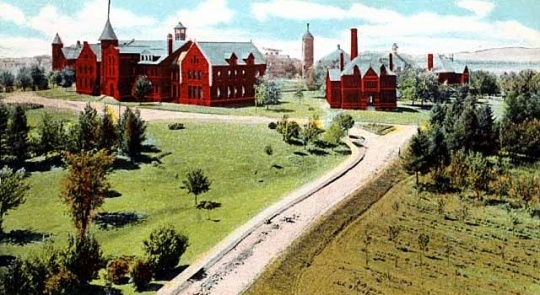
State public school, Owatonna
Public domain
Holding Location
More Information
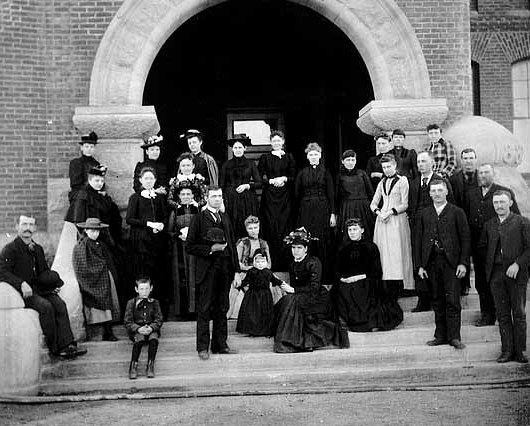
Faculty group at Owatonna State School
Public domain
Holding Location
More Information
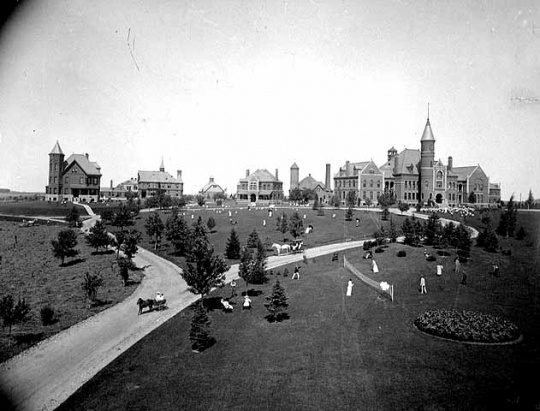
View of building and grounds, Owatonna State School
Public domain
Holding Location
More Information
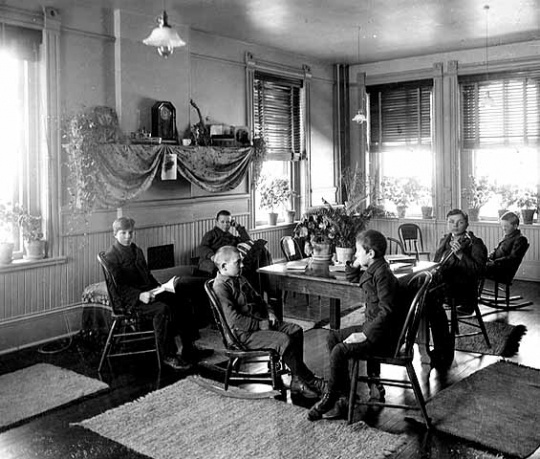
Interior cottage one, Owatonna State School, Owatonna
Holding Location
More Information
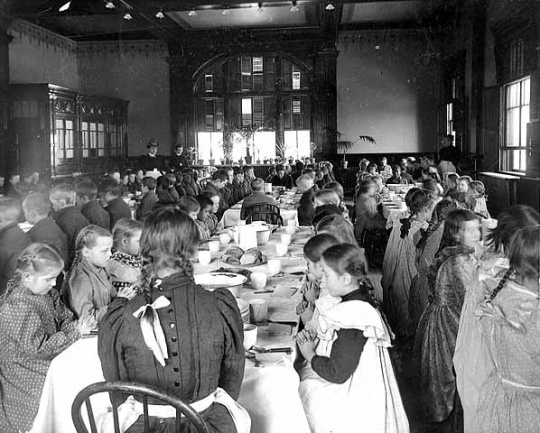
Dining room, Owatonna State School, Owatonna
Public domain
Holding Location
More Information

Exterior of cottage four at Owatonna State School, Owatonna
Public domain
Holding Location
More Information
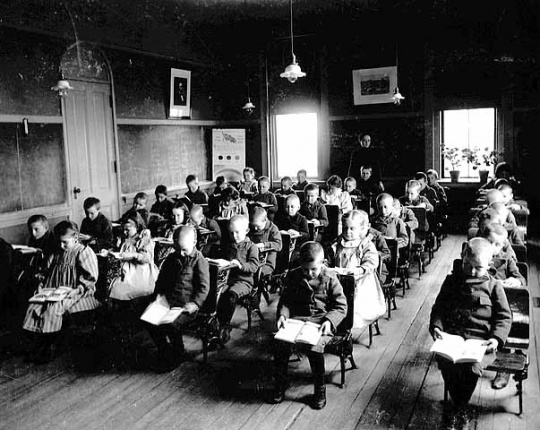
School room at Owatonna State School
Public domain
Holding Location
More Information
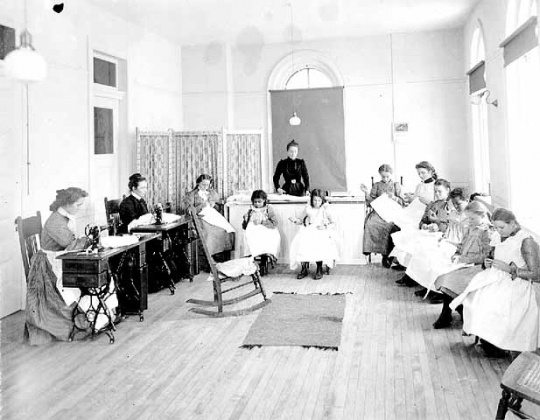
Sewing class at Owatonna State School
Public domain
Holding Location
More Information
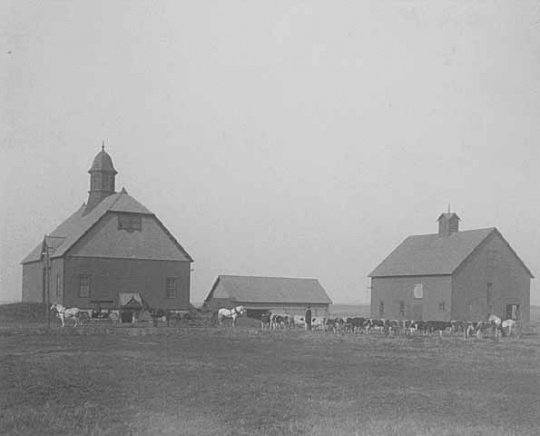
Farm buildings at Owatonna State School
Public domain
Holding Location
More Information
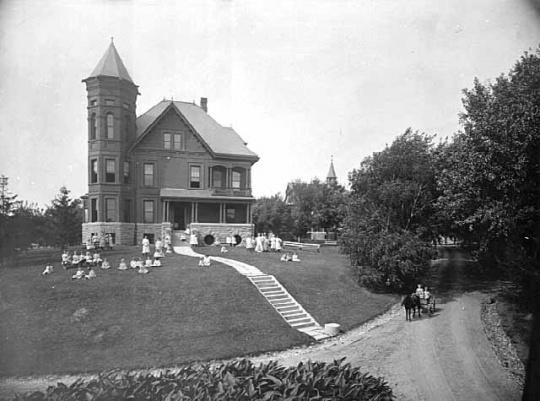
Girl's Cottage at the Owatonna State School
Public domain
Holding Location
More Information

Boys at work on the farm at the Owatonna State School
Public domain
Holding Location
More Information
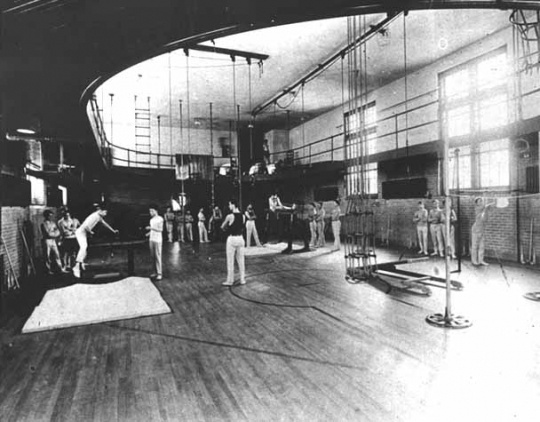
Gym class, Owatonna State School
Public domain
Holding Location
More Information
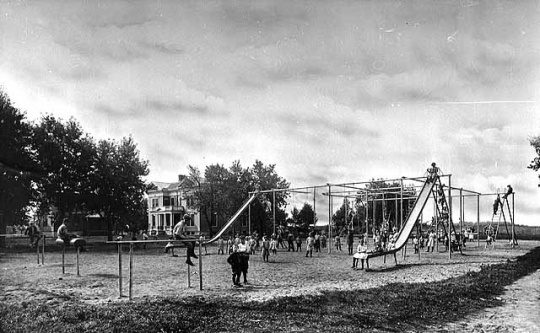
Playgrounds at the Owatonna State School
Public domain
Holding Location
More Information
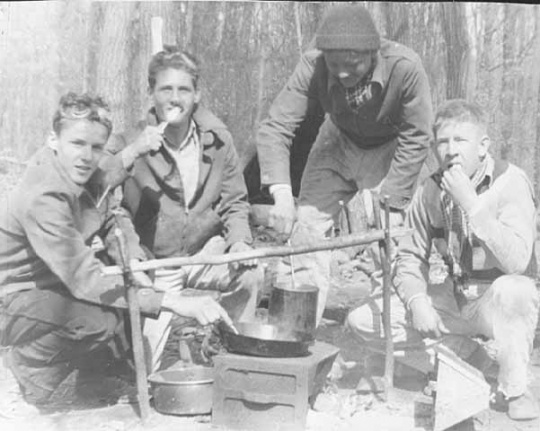
Boys from Owatonna State School on a campout
Holding Location
More Information
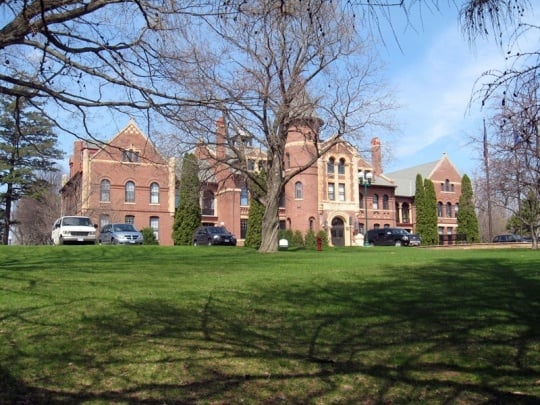
Main Building of the State Public School
All rights reserved
Holding Location
More Information
Related Articles
Turning Point
In December 1886 the Minnesota State Public School for Dependent and Neglected children admits its first three children, beginning over sixty years of operation.
Chronology
1885
1886
1914
1934
1937
1947
1975
1992
Bibliography
Minnesota State Public School for Neglected and Dependent Children, National Register of Historic Places Nomination File, State Historic Preservation Office, St. Paul
http://www.mnhs.org/shpo/nrhp/docs_pdfs/0002_mnspsdc.pdf
http://www.mnhs.org/shpo/nrhp/0002_image-gallery.htm
Editor's Note: This nomination file was the main source used in the writing of this article.
Related Resources
Primary
Admissions and Correspondence, 1890–1932
Minnesota State Public School
State Archives Collection, Minnesota Historical Society, St. Paul
Description: Superintendent's correspondence with county officials and members of the public.
Architectural Drawings, 1931–1935
Minnesota State Public School
State Archives Collection, Minnesota Historical Society, St. Paul
Description: Blueprints and specifications for two cottages and other additions to the school.
Biennial Reports, 1886–1938
Minnesota State Public School
State Archives Collection, Minnesota Historical Society, St. Paul
Description: Reports filed by the State Public School in Owatonna, Minnesota.
Buildings and Improvement Records, 1886–1928
Minnesota State Public School
State Archives Collection, Minnesota Historical Society, St. Paul
Description: Records documenting the construction, furnishing, and equipping of buildings on the State Public School campus.
Case Files, 1886–1945
Minnesota State Public School
State Archives Collection, Minnesota Historical Society, St. Paul
Description: Files on the children who lived at the State Public School in Owatonna, Minnesota.
Correspondence, Speeches, and Writings of Galen A. Merrill, 1886–1933
Manuscript Collection, Minnesota Historical Society, St. Paul
Description: Records kept by Galen A. Merrill, who was superintendent of the State Public School in Owatonna, Minnesota.
History of Children, 1886–1922
Minnesota State Public School
State Archives Collection, Minnesota Historical Society, St. Paul
Description: Information on the history of children admitted to the State Public School in Owatonna.
Index to Resident's Records, 1886–1945
Minnesota State Public School
State Archives Collection, Minnesota Historical Society, St. Paul
Description: Arranged alphabetical by name.
Journal and Ledger, 1901–1906
Minnesota State Public School
State Archives Collection, Minnesota Historical Society, St. Paul
Description: Kept by the Board of Control, detailing finances of the school.
Journal and Ledger, 1888–1894
Minnesota State Public School
State Archives Collection, Minnesota Historical Society, St. Paul
Description: Records financial operations of state institutions including the State Public School in Owatonna.
Merrill, Galen A. Minneapolis State Public School for Dependent Children: Survey of Results of Twenty-Eight Years of Work. Minneapolis: Syndicate Printing Co., 1915.
Minutes of the Board of Control and Board of Managers, 1885–1917
Minnesota State Public School
State Archives Collection, Minnesota Historical Society, St. Paul
Description: Focus on construction and maintenance, finances, staffing, and placement of children.
Photographs, Baptismal Certificates, Diplomas, and Diaries, [undated] and 1890–1933
Minnesota State Public School
State Archives Collection, Minnesota Historical Society, St. Paul
Description: Records of children who lived at the State Public School in Owatonna.
Photographs of Students, [c.1890]–1918
Minnesota State Public School
State Archives Collection, Minnesota Historical Society, St. Paul
Description: Photographs of individual students arranged in alphabetical order.
Placement Record, 1887–1942
Minnesota State Public School
State Archives Collection, Minnesota Historical Society, St. Paul
Description: Records of placement and indenture of children.
Placement Record by County, 1887–1943
State Archives Collection, Minnesota Historical Society, St. Paul
Description: Registers by county of children indentured.
Record of Children, 1887–1945
Minnesota State Public School
State Archives Collection, Minnesota Historical Society, St. Paul
Description: Adoption records.
Record of Children Received, 1886–1938
Minnesota State Public School
State Archives Collection, Minnesota Historical Society, St. Paul
Description: The admission book of the State Public School in Owatonna, Minnesota.
Ronglien, Harvey. "Girls at the Owatonna State School." Owatonna Post, 25 July 1996.
———. "Life was not easy at the State School." Owatonna Post, 18 July 1996.
Statistical Record [History of Children]. 1891–1922
Minnesota State Public School
State Archives Collection, Minnesota Historical Society, St. Paul
Description: Adoption records.
Superintendent's Correspondence, 1886–1934
Minnesota State Public School
State Archives Collection, Minnesota Historical Society, St. Paul
Description: The correspondence of Superintendent Galen A. Merrill and his clerk, Emily M. Oberlin.
Superintendent's Reports, 1886–1945
Minnesota State Public School
State Archives Collection, Minnesota Historical Society, St. Paul
Description: Reports of the superintendent to the State Board of Control or the State Public School's board of commissioners.
Superintendent Subject Files, 1885–1953
Minnesota State Public School
State Archives Collection, Minnesota Historical Society, St. Paul
Description: Papers relating to the administration of the State Public School in Owatonna, Minnesota.
Secondary
Ashley, LeRoy. Saving the Waifs: Reformers and Dependent Children, 1890–1917. Philadelphia: Temple University Press, 1984.
Askeland, Lori, ed. Children and Youth in Adoption, Orphanages, and Foster Care: A Historical Handbook and Guide. Westport, CT: Greenwood Press, 2006.
Banner, Lois. "Religious Benevolence as Social Control: A Critique of an Interpretation." Journal of American History 60, 1 (June 1973): 23–41.
Brace, Charles Loring. The Dangerous Classes of New York and Twenty Years' Work Among Them. Silver Spring, MD: National Association of Social Workers, 1973. Originally published 1872.
Brown, Dorothy M., and Elizabeth KcKeown, The Poor Belong to Us, Catholic Charities and American Welfare. Cambridge: Harvard University Press, 1997.
Bruno, Frank J. Trends in Social Work, 1874–1956: A History Based on the Proceedings of the National Conference of Social Work. New York: N.p., 1957.
Carp, E. Wayne. "Orphanages vs. Adoption: The Triumph of Biological Kinship, 1800–1933," in With Us Always: A History of Private Charity and Public Welfare, Donald T. Critchlow and Charles H. Parker, eds. Lanham, MD: Rowman and Littlefield, 1999.
"Clarence H. Johnston, Sr., A Great Architect." Northwest Architect, 1 (Jan. 1937): 9.
Clement, Priscilla Ferguson. "With Wise and Benevolent Purpose: Poor Children and the State Public School at Owatonna, 1885–1915." Minnesota History 49, no. 1(Spring 1984): 3–12.
http://collections.mnhs.org/MNHistoryMagazine/articles/49/v49i01p002-013.pdf
Curtis, Florence Rising. "Institutional Libraries," Bulletin of the University of Minnesota, 1918.
Curtis, Henry Stoddard. The Play Movement and Its Significance. New York: Macmillan Co., 1917.
Dulberger, Judith Ann. "Refuge or Repressor: The Role of the Orphan Asylum in Lives of Poor Children and Their Families in Late-Nineteenth Century America." Ph.D. Dissertation, Carnegie-Mellon University, 1988.
Folks, Homer. "Four Milestones of Progress." Annals of the American Academy of Political and Social Science, 212 (November 1940):12–17.
———. The Care of Destitute, Neglected, and Delinquent Children. Albany: J. B. Lyon, 1900.
Folwell, William Watts. A History of Minnesota. St. Paul: Minnesota Historical Society Press, 1969.
Griffin, Clifford S. Their Brother's Keepers: Moral Stewardship in the United States, 1800–1865. New Brunswick, NJ: Rutgers University Press, 1960.
Hart, Hastings. "Placing Out Children in the West," Proceedings of the National Conference of Charities & Correction. St. Louis, MO: The Conference,1884.
———. Preventive Treatment of Neglected Children. New York: Charities Publication Committee, 1910.
Hasci, Timothy. "From Indenture to Family Foster Care: A Brief History of Child Placing," in A History of Child Welfare, ed. Eve P. Smith and Lisa A. Merkel-Holguin, 155–173. New Brunswick, NJ: Transaction Publishers, 1996.
Johnston, Clarence H. "A Renaissance in Institution Building." Quarterly, Conference of the Executive Officers of State Institutions with the State Board of Control at the School for the Feeble-Minded, Faribault, MN, May 5th and 6th, 1919.
Jones, Marshall B. "Crisis of the American Orphanage, 1931–1940." Social Service Review (December 1989): 613–629.
Katz, Michael B.. In the Shadow of the Poorhouse: A Social History of Welfare in America. New York: Basic Books, 1986.
———, Michael J. Doucet, and Mark J. Stern. The Social Organization of Early Industrial Capitalism. Cambridge, MA: Harvard University Press, 1982.
Langsam, Miriam Z. Children West: A History of the Placing-Out System of the New York Children's Aid Society, 1853–1890. Madison, WI: The State Historical Society of Wisconsin, 1964.
Larson, Paul Clifford. Minnesota Architect: The Life and Work of Clarence H. Johnston. Afton, MN: Afton Historical Society Press, 1996.
Lee, Joseph. Play in Education. New York: Macmillan Co., 1915.
Leonard, Clara T."Family Homes for Pauper and Dependent Children." National Conference of Charities and Correction, Proceedings, 1879.
Levin, Esther. "Fifty Years of Child Care: Children's Home Society of Minnesota, 1889–1939." Master's thesis, University of Minnesota, 1939.
Lynch, Claire. "The Protestant Orphanage, 1865–1935." Typescript, Minnesota Historical Society, 1977.
Ma, Gioh-Fang Dju. One Hundred Years of Public Services for Children in Minnesota. Chicago: University of Chicago Press, 1948.
Martell, Diane. "From Production to Protection: The Evolution of a Child Welfare System." Paper presented at the Annual Conference of the Society for Historical Archaeology, Providence, RI, January 15, 2003.
McClure, Ethel. More than a Roof: The Development of Minnesota Poor Farms and Homes for the Aged. St. Paul: Minnesota Historical Society Press, 1968.
Merrill, Galen A. "Some Recent Developments in Child-Saving." Proceedings of the National Conference of Charities and Correction, 1900.
Morton, Marian J., "Surviving the Great Depression: Orphanages and Orphans in Cleveland." Journal of Urban History, 26 (2000): 438–455.
Pappenfort, Donnell M., Adelaide Dinwoodie, and Dee Morgan Kilpatrick, "Children in Institutions, A Research Note." Social Service Review, 42 (1966).
Patterson, R. S., and Patricia Rooke, "The Delicate Duty of Child Saving: Coldwater, Michigan, 1871–1896." Michigan History, 61 (Fall 1977): 195–219.
Peck, Emelyn Foster, ed. U.S. Children's Bureau, Adoption Laws in the United States: A Summary of the Development of Adoption Legislation and Significant Features of Adoption Statutes, With the Text of Selected Laws, Bureau Publication No. 148. Washington, DC: Government Printing Office, 1925.
Rainwater, Clarence. The Play Movement in the United States: A Study of Community Recreation. Chicago: University of Chicago Press, 1922.
Razor, Peter. While the Locust Slept. St. Paul: Minnesota Historical Society Press, 2002.
Randall, C. D. "The Michigan System of Child Saving." American Journal of Sociology, 1 (1896).
Ronglien, Harvey. A Boy from C-ll: Case #9164. Owatonna, MN: Graham Megyeri Books, 2006.
Rosnes, Catherine."History of the Protestant Orphan Asylum of St. Paul, Minnesota, and the Development of Children's Services, Inc." Master's thesis, University of Minnesota, 1948.
U.S. Department of Commerce and Labor, Bureau of the Census. Benevolent Institutions, 1904. Washington: Government Printing Office, 1905.
Videotape #935
Audiovisual Collection, Minnesota Historical Society, St. Paul
"The Children Remember: Life at the Minnesota State Public School for Dependent and Neglected Children."
Description: Documentary film which tells the story of children who lived at the State Public School in Owatonna.
Web
Minnesota Historical Society. Family History: Types of Family History Resources, Using Owatonna State Public School Records.
http://www.mnhs.org/genealogy/family/genieguide/owatonna_school.htm
Minnesota State School for Dependent and Neglected Children. History.
http://www.orphanagemuseum.com/staterun.html
















